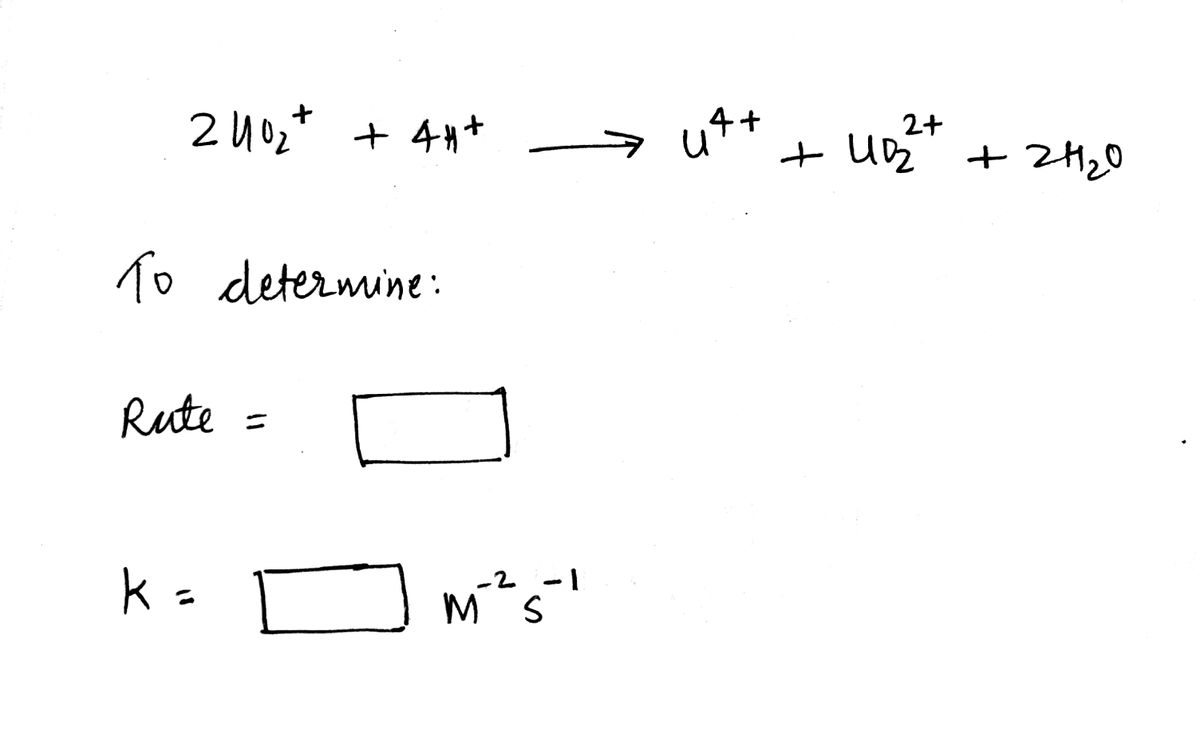The following initial rate data are for the reaction of UO₂+ with hydrogen ion in aqueous solution: 2+ 2UO₂+ + 4H+ → U¹+ + UO₂²+ + 2H₂O Experiment [UO₂+], M [H+]o, M Initial Rate, M.s¯¹ 0' S 0.00458 0.714 0.00238 0.00916 0.714 0.00953 0.00458 1.43 0.00477 0.00916 1.43 0.0191 Complete the rate law for this reaction in the box below. Use the form k[A] [B]", where '1' is understood for 1 2 3 4 m or n and concentrations taken to the zero power do not appear. Don't enter 1 for m or n. Rate = k = M-2 S-1
The following initial rate data are for the reaction of UO₂+ with hydrogen ion in aqueous solution: 2+ 2UO₂+ + 4H+ → U¹+ + UO₂²+ + 2H₂O Experiment [UO₂+], M [H+]o, M Initial Rate, M.s¯¹ 0' S 0.00458 0.714 0.00238 0.00916 0.714 0.00953 0.00458 1.43 0.00477 0.00916 1.43 0.0191 Complete the rate law for this reaction in the box below. Use the form k[A] [B]", where '1' is understood for 1 2 3 4 m or n and concentrations taken to the zero power do not appear. Don't enter 1 for m or n. Rate = k = M-2 S-1
Principles of Modern Chemistry
8th Edition
ISBN:9781305079113
Author:David W. Oxtoby, H. Pat Gillis, Laurie J. Butler
Publisher:David W. Oxtoby, H. Pat Gillis, Laurie J. Butler
Chapter18: Chemical Kinetics
Section: Chapter Questions
Problem 57AP
Related questions
Question
![The following initial rate data are for the reaction of UO₂+ with hydrogen ion in aqueous solution:
2+
2UO₂+ + 4H+ → U4+ + UO₂²+ + 2H₂O
+
Experiment [UO₂+]o, M [H]o, M Initial Rate, M. s-¹
0.00458
0.714
0.00238
0.00916
0.714
0.00953
0.00458
1.43
0.00477
0.00916
1.43
0.0191
Complete the rate law for this reaction in the box below.
Use the form
k[A] [B]", where '1' is understood for
1
2
3
4
m or
n and concentrations taken to the zero power do not appear. Don't enter 1 for
m or
n.
Rate =
k =
M-²
• S
-1](/v2/_next/image?url=https%3A%2F%2Fcontent.bartleby.com%2Fqna-images%2Fquestion%2Faf6a08b4-8e75-478e-afb6-07a17515e38d%2Fa412b910-1f56-4cce-b907-389e455e569e%2Fny5yexo_processed.png&w=3840&q=75)
Transcribed Image Text:The following initial rate data are for the reaction of UO₂+ with hydrogen ion in aqueous solution:
2+
2UO₂+ + 4H+ → U4+ + UO₂²+ + 2H₂O
+
Experiment [UO₂+]o, M [H]o, M Initial Rate, M. s-¹
0.00458
0.714
0.00238
0.00916
0.714
0.00953
0.00458
1.43
0.00477
0.00916
1.43
0.0191
Complete the rate law for this reaction in the box below.
Use the form
k[A] [B]", where '1' is understood for
1
2
3
4
m or
n and concentrations taken to the zero power do not appear. Don't enter 1 for
m or
n.
Rate =
k =
M-²
• S
-1
Expert Solution
Step 1

Trending now
This is a popular solution!
Step by step
Solved in 3 steps with 3 images

Knowledge Booster
Learn more about
Need a deep-dive on the concept behind this application? Look no further. Learn more about this topic, chemistry and related others by exploring similar questions and additional content below.Recommended textbooks for you

Principles of Modern Chemistry
Chemistry
ISBN:
9781305079113
Author:
David W. Oxtoby, H. Pat Gillis, Laurie J. Butler
Publisher:
Cengage Learning

Chemistry for Engineering Students
Chemistry
ISBN:
9781337398909
Author:
Lawrence S. Brown, Tom Holme
Publisher:
Cengage Learning

Chemistry: Principles and Practice
Chemistry
ISBN:
9780534420123
Author:
Daniel L. Reger, Scott R. Goode, David W. Ball, Edward Mercer
Publisher:
Cengage Learning

Principles of Modern Chemistry
Chemistry
ISBN:
9781305079113
Author:
David W. Oxtoby, H. Pat Gillis, Laurie J. Butler
Publisher:
Cengage Learning

Chemistry for Engineering Students
Chemistry
ISBN:
9781337398909
Author:
Lawrence S. Brown, Tom Holme
Publisher:
Cengage Learning

Chemistry: Principles and Practice
Chemistry
ISBN:
9780534420123
Author:
Daniel L. Reger, Scott R. Goode, David W. Ball, Edward Mercer
Publisher:
Cengage Learning

Chemistry: The Molecular Science
Chemistry
ISBN:
9781285199047
Author:
John W. Moore, Conrad L. Stanitski
Publisher:
Cengage Learning

Chemistry by OpenStax (2015-05-04)
Chemistry
ISBN:
9781938168390
Author:
Klaus Theopold, Richard H Langley, Paul Flowers, William R. Robinson, Mark Blaser
Publisher:
OpenStax

Chemistry & Chemical Reactivity
Chemistry
ISBN:
9781337399074
Author:
John C. Kotz, Paul M. Treichel, John Townsend, David Treichel
Publisher:
Cengage Learning